Describe how in the case of Vaishnavism, cults developed around the various avatars of the deity.
1. Ten avatars were recognised within the tradition. These were forms that the deity was believed to have in order to save the world whenever it was threatened by disorder and destruction because of the dominance of evil forces.
2. It is likely that different avatars were popular in different parts of the country. Recognising each of these local deities as a form of Vishnu was one way of creating a more unified religious tradition.
3. Shiva, for instance, was symbolised by the Linga although he was occasionally represented in human form too. All such representations depicted a complex set of ideas about the deities and their attributes through symbols such as head dresses, ornaments and Ayodhya.
4. To understand the meaning of these sculptures historians have to be familiar with the stories behind them many of which are contained in the Puranas, compiled by Brahmans (by about the middle of the first millennium CE). They contained much that had been composed and been in circulation for centuries, including stories about gods and goddesses. They are writing in Sanskrit verse generally.





